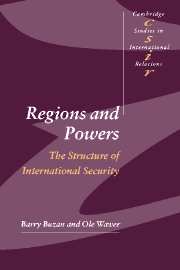Book contents
- Frontmatter
- Contents
- List of illustrations
- Preface
- List of abbreviations
- 1 Patterns of regional security during the Cold War
- 2 Patterns of regional security post-Cold War
- Part I Introduction: developing a regional approach to global security
- Part II Asia
- Introduction
- 4 South Asia: inching towards internal and external transformation
- 5 Northeast and Southeast Asian RSCs during the Cold War
- 6 The 1990s and beyond: an emergent East Asian complex
- Conclusions: scenarios for the Asian supercomplex
- Part III The Middle East and Africa
- Part IV The Americas
- Part V The Europes
- Part VI Conclusions
- Glossary
- References
- News media
- Index of names
- General Index
- CAMBRIDGE STUDIES IN INTERNATIONAL RELATIONS
5 - Northeast and Southeast Asian RSCs during the Cold War
Published online by Cambridge University Press: 05 December 2009
- Frontmatter
- Contents
- List of illustrations
- Preface
- List of abbreviations
- 1 Patterns of regional security during the Cold War
- 2 Patterns of regional security post-Cold War
- Part I Introduction: developing a regional approach to global security
- Part II Asia
- Introduction
- 4 South Asia: inching towards internal and external transformation
- 5 Northeast and Southeast Asian RSCs during the Cold War
- 6 The 1990s and beyond: an emergent East Asian complex
- Conclusions: scenarios for the Asian supercomplex
- Part III The Middle East and Africa
- Part IV The Americas
- Part V The Europes
- Part VI Conclusions
- Glossary
- References
- News media
- Index of names
- General Index
- CAMBRIDGE STUDIES IN INTERNATIONAL RELATIONS
Summary
An RSC covering all of East Asia is a recurrent pattern. Before and during the Second World War, Japanese power and imperial ambition linked Northeast and Southeast Asia together into a single security region. Earlier still, periodic waxings of Chinese power also brought these two regions into the same security sphere. But before the rise of imperial Japan in the late nineteenth century, and during waning periods of Chinese power, Northeast and Southeast Asia sometimes had largely separate regional security dynamics. During the Cold War, the patterns of regional security in East Asia were heavily penetrated by, but not completely subordinate to, the two superpowers. Although somewhat masked by Cold War patterns, this chapter will tell their story as separate Northeast and Southeast Asian RSCs, albeit with some interregional crossover by China (Buzan 1988a, 1988b, 1994). After the Cold War, penetration from the global level diminished substantially and altered in form, and the regional level story is best told on an East Asian scale. That will be the approach of chapter 6.
In Southeast Asia, decolonisation produced a fairly typical postcolonial conflict formation. It was almost entirely composed of weak states, but since most of these had solid historical roots, a set of relatively durable modern states eventually emerged. Like that in the Middle East, this RSC quickly became heavily penetrated by outside powers. In Northeast Asia, only the secondary states (Korea and Taiwan) were postcolonial.
- Type
- Chapter
- Information
- Regions and PowersThe Structure of International Security, pp. 128 - 143Publisher: Cambridge University PressPrint publication year: 2003



